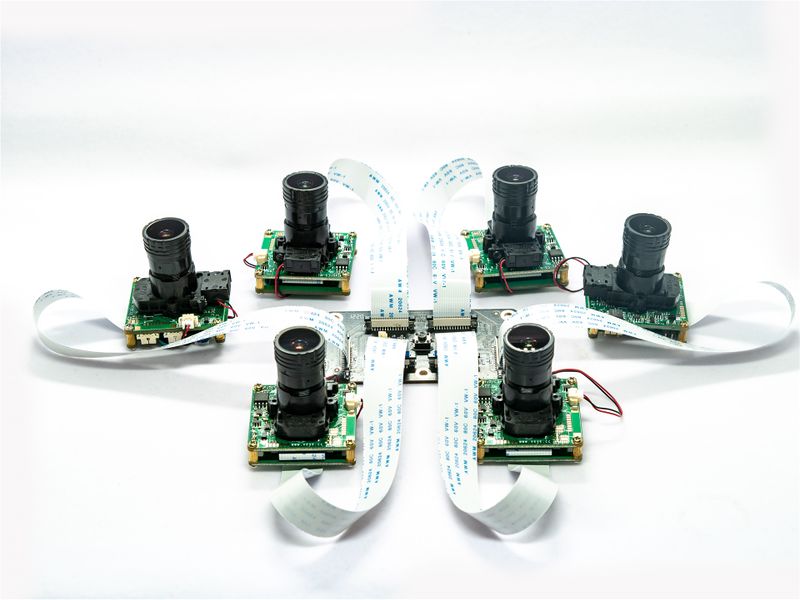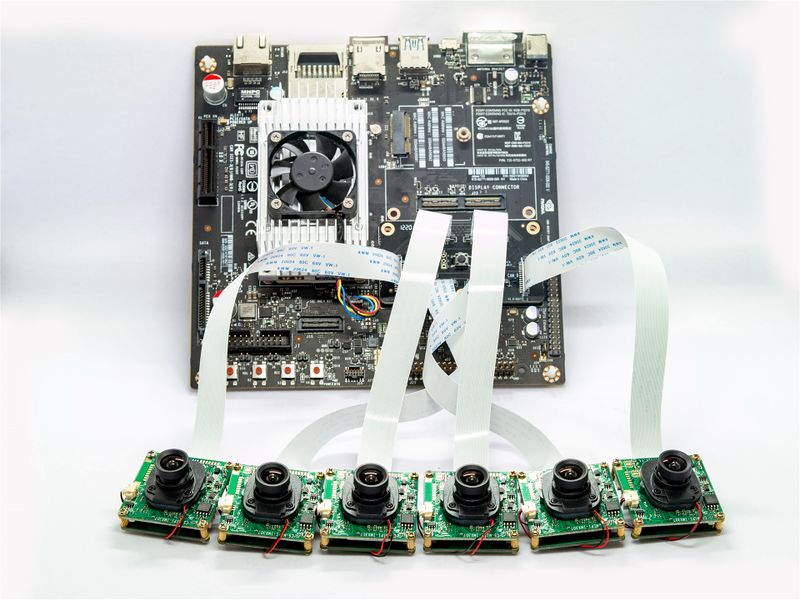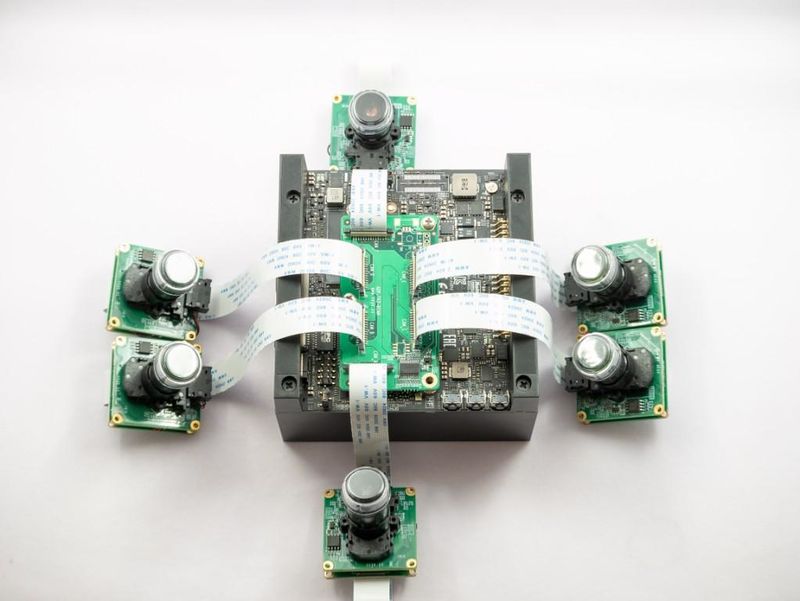VEYE CS Camera for Jetson TX2
How to use VEYE and CS series camera module on NVIDIA Jetson TX2 and AGX Xavier
1 Overview
This guide shows how to use VEYE and CS series camera modules on Jetson TX2 and AGX Xavier. Jetson JetPack SDK Version is r32.2.1. We provide two ways to do so: Prebuilt Binaries or Source Code. Yes, It's Open Source!
VEYE and CS series camera modules are STARVIS camera module with ISP functions build in. It output UYVY data using MIPI-CSI2. We provide V4L2 interface for video streaming apps , and Video Control Toolkits (which is Shell Script) to control the camera module directly, which is called DRA(Directly Register Access).
2 Hardware Setup
We have designed a 6cam interposer board for TX2 devkit and Xavier, It support up to 6 cameras at the same time.
2.1 NVIDIA TX2 Developer Kit
It is connected as shown in figure:
2.2 NVIDIA TX2 AGX Xavier
3 Upgrade Jetson TX2 and AGX Xavier system
3.1 Setting Up the Host PC Environment
- Cross-compiling Toolchain
Please refer to this link to install toolchain on your Host PC.
- L4T source code and Rootfs
You could use SDK Manager or directly download to get source code.
Sync code as this if you use SDK Manager:
./source_sync.sh -t tegra-l4t-r32.2.1
- Setting Up the Environment
Assume SDK install directory is <TOPDIR>,source code is in $L4T_DIR/sources directory.
- TX2
export TOP_DIR=/home/xumm/nvidia/nvidia_sdk/JetPack_4.2.2_Linux_GA_P3310/
- AGX Xavier
export TOP_DIR=/home/xumm/nvidia/nvidia_sdk/JetPack_4.2.2_Linux_GA_P2888/
export L4T_DIR=$TOP_DIR/Linux_for_Tegra
export LOCALVERSION=-tegra
export LDK_ROOTFS_DIR=$TOP_DIR/Linux_for_Tegra/rootfs
export ARCH=arm64
export CROSS_COMPILE=aarch64-linux-gnu-
export CROSS32CC=arm-linux-gnueabihf-gcc
export TEGRA_KERNEL_OUT=$L4T_DIR/sources/kernel/out_kernel
export KERNEL_PATH=$L4T_DIR/sources/kernel/out_kernel
export NVIDIA_PATH=$L4T_DIR/sources/kernel/nvidia
export TX2_DTS_PATH=$L4T_DIR/sources/hardware/nvidia/platform/t18x
export XAVIER_DTS_PATH=$L4T_DIR/sources/hardware/nvidia/platform/t19x
cd $L4T_DIR/sources/kernel/kernel-4.9/
- Build default image, flashing to Jetson Board, prepare L4T environment
cd $L4T_DIR
sudo ./apply_binaries.sh
- TX2
sudo ./flash.sh jetson-tx2 mmcblk0p1
- AGX Xavier
sudo ./flash.sh jetson-xavier mmcblk0p1
3.2 Download out bsp package for Jetson
cd $L4T_DIR
git clone https://github.com/veyeimaging/nvidia_jetson_veye_bsp.git
export RELEASE_PACK_DIR=$L4T_DIR/nvidia_jetson_veye_bsp
3.2.1 bsp package includes:
- prebuild linux kernel:Image
- prebuild dtb for different boards
- driver source code
- dts source code
- i2c toolkits
3.3 Using prebuild Image and DTB
- Installing the Kernel
Whether you use a prebuild kernel or you build it yourself
- TX2
copy Image to /boot/ dir on the Jetson TX2 board:
sudo cp <path to your Image dir>/Image /boot/Image -f
- AGX Xavier
on the Host PC:
cd $L4T_DIR
sudo ./flash.sh -k kernel jetson-xavier mmcblk0p1
- Flashing dtb file
Enter the recovery mode,and on the Host PC:
cp <path to your dtb dir>/dtbfilename $L4T_DIR/kernel/dtb/ -f
cd $L4T_DIR
- TX2
sudo ./flash.sh -r -k kernel-dtb jetson-tx2 mmcblk0p1
- AGX Xavier
sudo ./flash.sh -r -k kernel-dtb jetson-xavier mmcblk0p1
Reset Jetson Board after flashing.
3.4 Building from Source
3.4.1 Build kernel
- patch code
cp $RELEASE_PACK_DIR/drivers_source/cs_imx307\ veye327/* $NVIDIA_PATH/drivers/media/i2c/
cp $RELEASE_PACK_DIR/drivers_source/kernel_csimx307veye327_config $L4T_DIR/sources/kernel/kernel-4.9/arch/arm64/configs/tegra_csimx307veye327_defconfig
- build
cd $L4T_DIR/sources/kernel/kernel-4.9/
make ARCH=arm64 O=$TEGRA_KERNEL_OUT tegra_csimx307veye327_defconfig
make ARCH=arm64 O=$TEGRA_KERNEL_OUT Image -j4
Completed Image file is $TEGRA_KERNEL_OUT/arch/arm64/boot/Image,could be used for Flashing or Upgrading.
Install Image for Flashing:
sudo cp $TEGRA_KERNEL_OUT/arch/arm64/boot/Image $L4T_DIR/kernel/ -f
3.4.2 Build DTS
- patch code
- Jetson TX2
cp $RELEASE_PACK_DIR/TX2/JetPack_4.2.2_Linux_GA_P3310/dts\ dtb/common/t18x/* -r $TX2_DTS_PATH/
For CS-MIPI-IMX307
cp $RELEASE_PACK_DIR/TX2/JetPack_4.2.2_Linux_GA_P3310/dts\ dtb/CS-MIPI-IMX307/tegra186-quill-p3310-1000-a00-00-base.dts $TX2_DTS_PATH/quill/kernel-dts/
For VEYE-MIPI-327
cp $RELEASE_PACK_DIR/TX2/JetPack_4.2.2_Linux_GA_P3310/dts\ dtb/VEYE-MIPI-327/tegra186-quill-p3310-1000-a00-00-base.dts $TX2_DTS_PATH/quill/kernel-dts/
- AGX Xavier
cp $RELEASE_PACK_DIR/AGX-Xaviar/JetPack_4.2.2_Linux_GA_P2888/dts\ dtb/common/t19x/* -r $XAVIER_DTS_PATH/
For CS-MIPI-IMX307
cp $RELEASE_PACK_DIR/AGX-Xaviar/JetPack_4.2.2_Linux_GA_P2888/dts\ dtb/CS-MIPI-IMX307/tegra194-p2888-0001-p2822-0000.dts $TX2_DTS_PATH/galen/kernel-dts/
For VEYE-MIPI-327
cp $RELEASE_PACK_DIR/AGX-Xaviar/JetPack_4.2.2_Linux_GA_P2888/dts\ dtb/VEYE-MIPI-327/tegra194-p2888-0001-p2822-0000.dts $TX2_DTS_PATH/galen/kernel-dts/
- build
cd $L4T_DIR/sources/kernel/kernel-4.9/
make ARCH=arm64 O=$TEGRA_KERNEL_OUT dtbs
Could be used for Flashing or Upgrading.
4 Applications and Test
4.1 Check system status
Run the following command to confirm whether the camera is probed.
- For VEYE-MIPI-327
dmesg | grep veye327
The output message appears as shown below.:
Detected VEYE327 sensor
subdev veye327 3X-003b bound
此外,检查/dev/videoX设备节点,应当是存在的。
- For CS-MIPI-IMX307
dmesg | grep csimx307
The output message appears as shown below.:
Detected CS307 sensor
subdev csimx307 3X-003b bound
- Run the following command to check the presence of video node.
ls /dev/video*
The output message appears as shown below.
videoX
4.2 Video Stream Toolkits Manual
Our camera appears as /dev/videoX device node,where X is between [0-5].
in gstreamer command ,v4l2src has a param device=/dev/videoX to identify which camera to use.
4.2.1 Gstreamer Usage
- Preview FHD(HW accelerated)
gst-launch-1.0 v4l2src device=/dev/video0 ! "video/x-raw,format=(string)UYVY, width=(int)1920, height=(int)1080" ! nvvidconv ! "video/x-raw(memory:NVMM),format=(string)I420" ! nvoverlaysink sync=false
- Preview 720p@60 (CS-MIPI-IMX307,HW accelerated)
gst-launch-1.0 v4l2src ! "video/x-raw,format=(string)UYVY, width=(int)1280, height=(int)720, framerate=(fraction)60/1" ! nvvidconv ! "video/x-raw(memory:NVMM),format=(string)I420" ! nvoverlaysink sync=false
- Preview 2 cameras 1080p HD(HW accelerated)
WIDTH=960
HEIGHT=540
CAPS="video/x-raw,format=(string)UYVY, width=1920, height=1080"
gst-launch-1.0 nvcompositor name=comp sink_0::xpos=0 sink_0::ypos=0 sink_0::width=$WIDTH sink_0::height=$HEIGHT sink_1::xpos=$WIDTH sink_1::ypos=0 sink_1::width=$WIDTH sink_1::height=$HEIGHT ! nvoverlaysink v4l2src device=/dev/video0 ! $CAPS ! nvvidconv ! "video/x-raw(memory:NVMM),format=(string)I420"! comp. v4l2src device=/dev/video1 ! $CAPS ! nvvidconv ! "video/x-raw(memory:NVMM),format=(string)I420"! comp.
- Record FHD in H.264 format to a video file(HW accelerated)
gst-launch-1.0 v4l2src num-buffers=300 ! "video/x-raw,format=(string)UYVY, width=(int)1920, height=(int)1080" ! nvvidconv ! "video/x-raw(memory:NVMM),format=(string)I420" ! omxh264enc qp-range=20,20:20,20:-1,-1 ! matroskamux ! queue ! filesink location=videoname.mkv
- Playback of saved video file (HW accelerated)
gst-launch-1.0 filesrc location=videoname.mkv ! matroskademux ! h264parse ! omxh264dec ! nvoverlaysink
- Capturing FHD still image
gst-launch-1.0 v4l2src num-buffers=1 ! "video/x-raw,format=(string)UYVY, width=(int)1920, height=(int)1080" ! jpegenc ! filesink location=jpgname.jpg
4.3 Video Control Toolkits Manual
- i2c bus description:
ADP-TX2-6CAM has 6 MIPI CSI-2 interface [A-F],the corresponding i2c address is[30-35].
It is also the same as the 3X part of dmesg message:
subdev veye327 3X-003b bound
subdev csimx307 3X-003b bound
using -b option to identify which bus you want to use.
- VEYE-MIPI-327
Video Control Toolkits Manual :VEYE-MIPI-327 I2C
- CS-MIPI-IMX307
Video Control Toolkits Manual :CS-MIPI-IMX307 I2C
5 Realtimes RTSO-9001
5.1 Hardware Setup
Matching with Realtimes RTSO-9001, you need to use RTST-RPI adapter board.
Note: the power supply capacity of the MIPI CSI-2 interface of the current version of RTSO-9001 is not enough to support the power requirements of our camera, which requires an additional 5V power supply to the camera. It is not shown in the picture above.
5.2 Software bsp
- The corresponding directory for Realtimes RTSO-9001, is:
nvidia_jetson_veye_bsp\TX2\JetPack_4.2.2_Linux_RTSO-9001
- Subject to the agreement with Ruitai, we do not release the source code
- Our code have been submitted to Realtimes, and customers are advised to contact Realtimes for a complete version of the supported image.
6 References
Jetson start up: https://developer.nvidia.com/embedded/learn/getting-started-jetson
TX2 development kit: https://developer.nvidia.com/embedded/jetson-tx2-developer-kit
SDK Manager: https://docs.nvidia.com/sdk-manager/index.html
TX2 user guide: link
Realtimes website:http://www.realtimes.cn/



